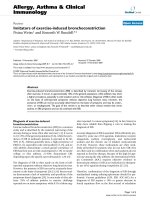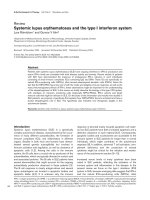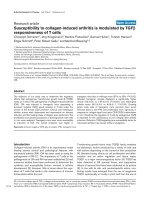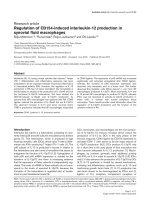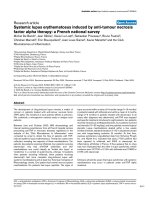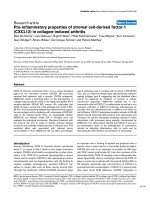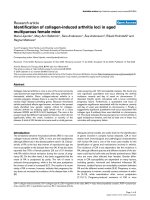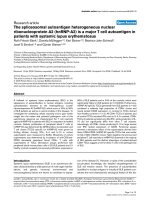Báo cáo y học: "Systemic lupus erythematosus induced by anti-tumour necrosis factor alpha therapy: a French national survey" ppsx
Bạn đang xem bản rút gọn của tài liệu. Xem và tải ngay bản đầy đủ của tài liệu tại đây (122.49 KB, 7 trang )
Open Access
Available online />R545
Vol 7 No 3
Research article
Systemic lupus erythematosus induced by anti-tumour necrosis
factor alpha therapy: a French national survey
Michel De Bandt
1
, Jean Sibilia
2
, Xavier Le Loët
3
, Sebastian Prouzeau
4
, Bruno Fautrel
5
,
Christian Marcelli
6
, Eric Boucquillard
7
, Jean Louis Siame
8
, Xavier Mariette
9
and the Club
Rhumatismes et Inflammation
1
Rheumatology Department, Hôpital Robert Ballanger, Aulnay sous Bois, France
2
CHU Hautepierre, Strasbourg, France
3
Hôpital Bois-Guillaume, Rouen, France
4
Hôpital de Saint Lo, Saint Lo, France
5
Hôpital Pitié Salpétrière, Assistance Publique-Hôpitaux de Paris, Paris, France
6
CHU côte de Nacre, Caen, France
7
Hôpital de Saint Pierre de la Réunion, St Pierre France
8
Polyclinique de Riaumont, Liévin, France
9
Hôpital de Bicêtre, Assistance Publique-Hôpitaux de Paris, Le Kremlin Bicêtre, France
Corresponding author: Michel De Bandt,
Received: 29 Nov 2004 Revisions requested: 29 Dec 2004 Revisions received: 7 Feb 2005 Accepted: 10 Feb 2005 Published: 1 Mar 2005
Arthritis Research & Therapy 2005, 7:R545-R551 (DOI 10.1186/ar1715)
This article is online at: />© 2005 De Bandt et al., licensee BioMed Central Ltd.
This is an Open Access article distributed under the terms of the Creative Commons Attribution License ( />2.0), which permits unrestricted use, distribution, and reproduction in any medium, provided the original work is properly cited.
Abstract
The development of drug-induced lupus remains a matter of
concern in patients treated with anti-tumour necrosis factor
(TNF) alpha. The incidence of such adverse effects is unknown.
We undertook a retrospective national study to analyse such
patients.
Between June and October 2003, 866 rheumatology and
internal medicine practitioners from all French hospital centres
prescribing anti-TNF in rheumatic diseases registered on the
website of the 'Club Rhumatismes et Inflammation' were
contacted by email to obtain the files of patients with TNF-
induced systemic lupus erythematosus. Twenty-two cases were
collected, revealing two aspects of these manifestations. Ten
patients (six patients receiving infliximab, four patients receiving
etanercept) only had anti-DNA antibodies and skin
manifestations one could classify as 'limited skin lupus' or
'toxidermia' in a context of autoimmunity, whereas 12 patients
(nine patients receiving infliximab, three patients receiving
etanercept) had more complete drug-induced lupus with
systemic manifestations and at least four American Congress of
Rheumatology criteria. One patient had central nervous system
manifestations. No patients had lupus nephritis. The signs of
lupus occurred within a mean of 9 months (range 3–16 months)
in patients treated with infliximab and within a mean of 4 months
(range 2–5 months) in patients treated with etanercept. In all
cases after diagnosis was determined, anti-TNF was stopped
and specific treatment introduced in eight patients: two patients
received intravenous methylprednisolone, four patients received
oral steroids (15–35 mg/day), and two patients received topical
steroids. Lupus manifestations abated within a few weeks
(median 8 weeks, standard deviation 3–16) in all patients except
one with longer-lasting evolution (6 months). At that time,
cautious estimations (unpublished data from Schering Plough
Inc. and Wyeth Inc.) indicated that about 7700 patients had
been exposed to infliximab and 3000 to etanercept for
inflammatory arthritides in France. It thus appears that no drug
was more implicated than the other in lupus syndromes, whose
incidence was 15/7700 = 0.19% with infliximab and 7/3800 =
0.18% with etanercept.
Clinicians should be aware that lupus syndromes with systemic
manifestations may occur in patients under anti-TNF alpha
treatment.
ACL = anticardiolipin antibodies; ACR = American Congress of Rheumatology; ANA = antinuclear antibodies; ELISA = enzyme-linked immunosorb-
ent assay; ENA = extractable nuclear antigens; IL = interleukin; RA = rheumatoid arthritis; SLE = systemic lupus erythematosus; TNF = tumour necro-
sis factor.
Arthritis Research & Therapy Vol 7 No 3 De Bandt et al.
R546
Introduction
Therapy with anti-tumour necrosis factor (TNF) alpha is effec-
tive for rheumatoid arthritis (RA) [1,2], with an estimated
500,000 patients being treated worldwide. The possible
occurrence of drug-induced autoimmune disorders remains a
matter of concern [3]because induction of autoantibodies is
frequently observed in patients treated with TNF alpha inhibi-
tors [4]. Of concern is the possible induction of lupus-like (or
drug-induced lupus) syndromes, but few cases have been
reported [5-7]. In all reported cases, the signs disappeared
after treatment was stopped. The incidence of cases is
unknown.
We report here the results of a French national survey reveal-
ing 22 cases of drug-induced lupus erythematosus (systemic
lupus erythematosus [SLE]) in French patients being treated
with anti-TNF alpha for inflammatory arthritides.
Methods
Between June and October 2003, the 'Club Rhumatismes et
Inflammation', a section of the French Society of Rheumatol-
ogy, carried out a retrospective survey among all French rheu-
matologists and specialists in internal medicine to uncover
cases of SLE with anti-TNF alpha treatment (infliximab or
etanercept at that time). Eight hundred and sixty-six rheumatol-
ogy and internal medicine practitioners from all the French
hospital centres prescribing anti-TNF in rheumatic diseases,
registered on the website of the Club Rhumatismes et Inflam-
mation
, were contacted four times by
email at 1-month intervals to obtain the files of patients with
TNF-induced SLE. The study included all the patients ever
known to have developed an SLE-like illness during anti-TNF
treatment and not only those who developed an SLE-like ill-
ness during the 3-month study period.
As the prescription for anti-TNF alpha is limited to the hospitals
in France, all the units of rheumatology using biologics were
contacted. Eighteen units gave positive results, 22 gave neg-
ative results and very few (<10) did not participate. As all the
units of rheumatology using biologics were contacted and
most of them participated in the study, we can estimate that
the survey involved almost all of the French patients treated
with anti-TNF for arthritides. At that time, cautious estimations
indicated that about 7700 patients had been exposed to inflix-
imab and 3800 had been exposed to etanercept for inflamma-
tory arthritides in France (unpublished data from Schering
Plough Inc. and Wyeth Inc.).
As there are no recognized criteria for drug-induced lupus [8],
we considered diagnosis in the case of: a patient with anti-
TNF alpha treatment for inflammatory arthritides; a temporal
relationship between clinical manifestations and anti-TNF
alpha treatment; the presence of at least four American Con-
gress of Rheumatology (ACR) criteria of SLE [9]. Muscu-
loskeletal symptoms were taken into account only if they
reappeared with other lupus symptoms in a patient in whom
they had previously disappeared under anti-TNF therapy, and
isolated positive results for antinuclear antibodies (ANA) or
anti-dsDNA antibodies were not considered for diagnosis,
given their high frequency in patients under this therapy. Tele-
phone calls were made to collect information in the case of
missing data. Physicians were asked to provide information
about the clinical status of the patients and the presence of
lupus criteria. Information about the immunological status of
the patients was requested (before and after the onset of the
manifestations as well as after drug discontinuation).
The biological tests used for the detection of autoantibodies
were an indirect immunofluorescent assay for ANA, an ELISA
or Farr assay for anti-DNA antibodies, Ouchterlony's method
for anti-extractable nuclear antigens (anti-ENA), and an ELISA
for anti-histone, anti-Ro, anti-La, anti-SM, anti-RNP, anti-JO1,
anti-Topo 1, and anticardiolipin antibodies (ACL).
Results
A total of 32 patients was collected, three of which had been
previously described [5]. Ten patients were ruled out due to
improper diagnosis of lupus syndrome, due to pre-existing
lupus syndrome or due to mixed connective tissue disease
before introduction of anti-TNF alpha therapies. We observed
two types of manifestations among the remaining patients.
Ten patients (six patients treated with infliximab, four patients
treated with etanercept) had a diagnosis of 'anti-TNF-induced
SLE' based on three ACR criteria (Table 1). None of these
patients had previous signs of lupus before treatment except
one with isolated positive ANA. All of them had RA with joint
erosions. The mean age at onset of RA was 39 years (range
24–57 years), and the mean disease duration before onset of
'SLE' was 13 years (range 6–31 years). All patients had been
treated with a mean of five disease-modifying antirheumatic
drugs, including methotrexate in all cases. Before anti-TNF
therapy, no patients had clinical sign of lupus, one had positive
isolated ANA (1/160) without any other lupus criteria, and no
patients had anti-DNA or low complement. At the time of treat-
ment, all patients were being treated with steroids (mean 8
mg/day, range 4–16 mg/day) and methotrexate. No patient
had any other drug known as a lupus-inducing drug.
The only signs were isolated skin lesions (Table 2): pruritic
rash (two cases), butterfly rash (three cases), photosensitivity
(two cases), purpura (two cases), chilblains (one case), in a
context of autoimmunity with positive ANA and anti-dsDNA
antibodies. In all cases the clinical manifestations led to ceas-
ing the treatment with anti-TNF alpha, and the signs abated
quickly thereafter (<1 month). Despite the presence of three
manifestations or criteria for systemic lupus we did not con-
sider that these patients had drug-induced SLE, but rather that
they presented toxidermia associated with ANA. Moreover, all
Available online />R547
of these clinical manifestations are not specific for lupus.
Unfortunately no skin biopsy was performed.
Biological signs were positive results for ANA in all patients
(new onset or rise in titre, range 1/160–1/250°; three patients
with a speckled pattern, seven patients with a diffuse pattern).
A new onset of positive results for anti-dsDNA antibodies in
the 10 patients was noted by ELISA. None had any other bio-
logical and/or immunological manifestations of lupus. No con-
founding agent was involved in the occurrence of ANA and
anti-dsDNA.
Twelve other patients (10 females, two males; nine patients
receiving infliximab, three patients receiving etanercept) had a
diagnosis of drug-induced systemic lupus supported by the
presence of at least four ACR criteria (Tables 2 and 3). Eleven
patients had erosive and destructive RA and one patient had
severe psoriatic arthritis. The mean age at onset of RA was 36
years (range 14–54 years), and the mean disease duration
before onset of SLE was 16 years (range 3–40 years). All
patients had been treated with a mean of five disease-modify-
ing antirheumatic drugs (range 2–8), including methotrexate in
all cases.
Before anti-TNF therapy, no patients had clinical sign of lupus,
three had positive ANA (range 1/160–1/1280), one of these
(the patient with the highest level of ANA) had one time a limit
positive anti-dsDNA titre (ELISA test, 46 UI; normal value
<40), and nine had negative results. The two other patients
with positive ANA had positive anti-Ro antibodies, and a clini-
cal history of secondary Sjögren syndrome. None of the three
patients with positive ANA had any other sign or lupus criteria
(Table 2). Eleven patients had a typical history of severe and
erosive RA and one patient a history of severe psoriatic arthri-
tis. At the time of treatment, all patients were being treated
with steroids (mean 9 mg/day; range 5–15 mg/day) and meth-
otrexate (except one patient on etanercept alone).
Clinical signs were skin manifestations in 11 patients
(papules, alopecia, rash, butterfly rash, photosensitivity), gen-
eral manifestations in nine patients (fever, weight loss, asthe-
nia), reappearance of polyarthritis in six patients, inflammatory
myalgias in four patients, serositis in three patients, deep vein
thrombosis (twice) in one patient, lung disease (life-threaten-
ing pneumonitis) with pleuritis in one patient, and neuritis of
the third cranial nerve in one patient. No case of nephritis was
found. The mean ACR criteria number was 5.5 (range 4–7).
Skin lesions were largely symmetrical (arm, face, trunk) and
not at injection sites (in the case of etanercept). Histological
analysis (four patients) revealed atrophy of the epidermis,
necrosis of some keratinocytes, and perifollicular and
perivascular lymphocytic infiltration in the dermis without vas-
culitis. No indirect immunofluorescent test was performed.
The patient with deep vein thrombosis also had positive ACL
antibodies. Articular symptoms were taken into account only if
they reappeared with other lupus symptoms in a patient in
whom they had previously disappeared under anti-TNF ther-
apy and/or were different from previous complaints.
The patient with optical neuritis had no previous sign of multi-
ple sclerosis before treatment with infliximab; she had an iso-
lated neuritis of the third cranial nerve, with malar rash and
autoantibodies. The lumbar puncture was normal. Magnetic
resonance imaging showed an isolated hyper signal of the
third cranial nerve. Extensive research for other manifestations
of multiple sclerosis was performed without success. The
presence of the neurological manifestations with other clinical
Table 1
General presentation of the 10 patients with 'limited skin lupus' or toxiderma in a context of autoimmunity
Patient Before anti-TNF alpha treatment During onset of symptoms
Disease Autoantibody Clinical signs of
lupus
Treatment Duration of
treatment (months)
Clinical signs of
lupus
Biological signs of
lupus
1 RA, erosive RF+ None ETA 36 Skin ANA+, dsDNA+
2 RA, erosive RF+ None INF 6 Skin ANA+, dsDNA+
3 RA, erosive RF+, ANA+ 1:160° None INF 18 Skin ANA+, dsDNA+
4 RA, erosive RF- None ETA 5 Skin ANA+, dsDNA+
5 RA, erosive RF+ None INF 7 Skin ANA+, dsDNA+
6 RA erosive RF+ None ETA 5 Skin ANA+, dsDNA+
7 RA, erosive RF+ None INF 11 Skin ANA+, dsDNA+
8 RA, erosive RF+ None INF 3 Skin ANA+, dsDNA+
9 RA, erosive RF+ None ETA 12 Skin ANA+, dsDNA+
10 RA, erosive RF+ None INF 13 Skin ANA+, dsDNA+
ANA, antinuclear antibodies; dsDNA, double-strand DNA; ETA, etanercept; INF, infliximab; RA, rheumatoid arthritis; RF, rheumatoid factor; TNF,
tumour necrosis factor; +, positive; -, negative.
Arthritis Research & Therapy Vol 7 No 3 De Bandt et al.
R548
signs and autoimmunity led to the diagnosis of drug-induced
lupus.
Biological signs were positive results for ANA in all patients
(new onset or rise in titre, range 1/160–1/2560°; four with a
speckled pattern, eight with a diffuse pattern), and positive
results for anti-dsDNA antibodies (new onset) in 11 patients
by ELISA. Among the 11 patients tested with ELISA: five had
anti-IgM antibodies and six had a positive test with no more
detail; among them, three patients were tested by Farr assay
and were positive. The patient without anti-DNA had a high
titre of ANA, positive anti-ENA and anti-histone antibodies.
Positive anti-ENA antibodies were present in five patients (two
patients with previously known anti-SS-A/Ro antibodies, three
patients with newly detected anti-ENA antibodies with an uni-
dentified aspect), anti-histone in two patients and anti-cardiol-
ipin in six patients. Leucopenia (blood count <4000/mm
3
),
thrombopenia (blood count <100,000/mm
3
), lymphopenia
(blood count <1500/mm
3
) and positive Coombs test (without
haemolytic anaemia) were present in five patients, four
patients, two patients and one patient, respectively. Elevated
muscle enzymes were present in three of four patients with
inflammatory myalgias. One patient had isolated elevated cre-
atinin phosphokinase. No patient had muscle weakness. Tran-
sient low levels of C4 were detected in four cases (nine
tested).
The signs of SLE occurred in a mean of 9 months in patients
treated with infliximab and 4 months in patients treated with
etanercept. In all cases, after the diagnosis was determined,
the treatment was stopped and the manifestations then
abated within a few weeks (median 8 weeks, range 3–16
weeks), except one (patient 12, Table 2) with a longer lasting
evolution (6 months) before resolution. She had persistent
asthenia, immunological and haematological abnormalities
before resolution. But after 6 months all the signs abated. Bio-
logical signs normalized within a few months: in eight patients
the ANA results were negative, and in four they were reduced;
in nine patients, anti-dsDNA results were negative, and in
three patients they were reduced.
Table 2
General presentation of the 12 patients with 'complete lupus'
Patient Before anti-TNF alpha treatment During onset of symptoms
Disease Autoantibody Clinical signs
of lupus
Treatment Duration of
treatment (months)
Clinical signs of lupus
a
Biological signs of lupus
1 RA, RF+, erosive None None INF 27 General, skin, serositis,
lung
ANA+, dsDNA+, ACL+,
leucopenia, thrombopenia, ENA+
2 RA, RF+, erosive ANA+, Ro+ None INF 4 General, skin (3), arthritis ANA+, dsDNA+, histone +
3 RA, RF+, erosive ANA+, Ro+ None INF 2 Skin, myalgias, arthritis ANA+, dsDNA+, ENA+,
4 RA, RF-, erosive None None ETA 4 General, skin (2), myositis ANA+, dsDNA+, ACL+, low C4,
ENA+
5 RA, RF+, erosive None None INF 4 Skin (3), myositis, arthritis,
pericarditis
ANA+, dsDNA+, ACL+, CPK,
lymphopenia
6 RA, RF+, erosive ANA+, dsDNA+
limit value
None ETA 5 General, skin ANA+, dsDNA+, thrombopenia,
leucopenia
7 RA, RF+, erosive None None INF 10 General, serositis, myositis ANA+, dsDNA+, ACL+,
leucopenia, thrombopenia, CPK,
8 RA, RF+ None None ETA 2 Phlebitis, skin ANA+, dsDNA+, leucopenia,
ACL+, thrombopenia
9 Psoriatic arthritis None None INF 14 General, skin, neurological ANA+, dsDNA+
10 RA, RF+, erosive None None INF 16 General, Skin, arthritis ANA+, dsDNA+
11 RA, RF+, erosive None None INF 12 General, skin (3), arthritis,
myositis
ANA+, dsDNA+, ENA+, CPK
12 RA, RF+, erosive None None INF 10 General, skin, arthritis ANA+, dsDNA+, CPK, ENA+,
ACL+, low C4, histone+,
leucopenia, lymphopenia, Coombs
test+
ACL, positive anticardiolipin antibodies; ANA, antinuclear antibodies; CPK, creatin phospokinase or muscle enyme, elevated muscle enzymes;
dsDNA, double-strand DNA; ENA, positive anti-extractable nuclear antigens antibodies; ETA, etanercept; general, general manifestations (fever,
weight loss, asthenia); histone, positive anti-histone antibodies; INF, infliximab; RA, rheumatoid arthritis; RF, rheumatoid factor; TNF, tumour
necrosis factor; +, positive; -, negative.
a
The skin manifestations were as follows (number in parentheses indicates number of skin manifestations observed in one patient): maculo papular
rash observed in six patients, butterfly rash observed in five patients, alopecia present in one patient, photosensitivity observed in five patients,
purpuric lesions observed in two patients. One patient had no skin manifestations, seven patients had one sign, one patient had two different signs,
and three patients had three skin manifestations.
Available online />R549
Recovery was spontaneous without treatment in four cases.
Steroids were needed in the eight other patients: two patients
received topical steroids for skin lesions, two patients received
intravenous methylprednisolone, and four patients received
oral steroids (15–30 mg/day) for intense general signs. In no
patient did SLE signs reappear.
Cautious estimations at that time (unpublished data from
Schering Plough Inc. and Wyeth Inc.) indicated that about
7700 patients had been exposed to infliximab and 3800
patients had been exposed to etanercept for inflammatory
arthritides in France. The incidence of lupus syndromes was
thus the same with infliximab (15/7700 = 0.19%) and with
etanercept (7/3800 = 0.18%).
Discussion
We report on 22 patients treated with anti-TNF alpha for
severe RA or psoriatic arthritis (15 patients receiving infliximab
and seven patients receiving etanercept) with no previous sign
of lupus disease who developed clinical and biological mani-
festations of drug-induced lupus.
We are aware that the scientific interest of a retrospective
analysis is of limited value compared with a prospective study.
However, at that time only isolated case reports were availa-
ble. As far as we know, this survey is the only one providing fur-
ther information about the clinical problem of drug-induced
lupus. We hope that the national observatories and registers
that have been settled in various countries around the world
will precisely and prospectively answer the question of anti-
TNF-induced lupus.
Analysis of the cases revealed two subgroups of patients. The
first group of patients was considered by the referring physi-
cian as 'drug-induced lupus'. In our opinion these patients had
what we term 'toxidermia' – that is, isolated skin manifestations
in a context of autoimmunity and the absence of systemic man-
ifestations. We are aware that some colleagues will feel
uneasy with the term 'toxidermia' and would prefer to qualify
these patients as 'incomplete lupus with isolated skin manifes-
tations'. We do understand the reserve about the expression
'toxidermia' rather than 'drug-induced lupus erythematosus'.
We preferred to be rigorous with the diagnosis of SLE and to
use a more stringent definition (at least four ACR criteria for
SLE) to describe a core of patients. Indeed, patients treated
with anti-TNF (mostly infliximab rather than etanercept) have
frequent and isolated skin manifestations with positive autoan-
tibodies. The frequency of these clinical pictures is unknown
but seems important regarding the frequency of autoantibod-
ies (up to 50% for ANA, 25% for ACL and 15% for anti-DNA
with infliximab) and of skin manifestations [3-7,10-12]. Do all
these patients only have toxidermia in a context of autoimmu-
nity or 'limited drug-induced skin lupus'?
The second group of 12 patients had what we considered true
'drug-induced SLE' with at least four ACR criteria and sys-
temic manifestations, with a very acute and complete syn-
drome, associating general manifestations and clinical and
biological signs of lupus. All 12 patients fulfilled the ACR cri-
teria for SLE [9], and did not simply have drug-induced skin
toxidermia in a context of autoimmunity. Clinicians should thus
be aware that lupus syndromes may occur in patients under
anti-TNF alpha treatment and may be complicated by central
Table 3
Signs of systemic lupus erythematosus (SLE) in 12 patients under anti-tumour necrosis factor alpha treatment
Sign of SLE Number of patients
Skin (≥ 1 SLE skin criteria) 11
General (fever, weight loss, asthenia) 9
Musculoskeletal (arthritis, myositis, myalgias) 10 (6 arthritis, 3 myositis, 1 myalgia)
Serositis, lung, neuritis, phlebitis; haematological abnormalities,
elevated muscle enzymes
3, 1, 1 and 1, respectively; 12 and 3, respectively
Antibody testing
Positive for ANA (>1/160) 12
Positive for anti-dsDNA antibodies (>40 UI) 11
Positive anti-ENA, anti-histone, anti-cardiolipid 5, 2 and 6, respectively
Recovery
After treatment withdrawn (with/without steroids) 12 (4 and 8)
Delay in recovery (median and range) 8 weeks (3–16 weeks)
Ten females, two males; nine patients treated with infliximab and three patients treated with etanercept. ANA, antinuclear antibodies; dsDNA,
double-strand DNA; ENA, positive anti-extractable nuclear antigensantibodies.
Arthritis Research & Therapy Vol 7 No 3 De Bandt et al.
R550
nervous system signs. However, withdrawal of the drug leads
to an abatement of the signs.
ACL antibodies were detected in six patients whereas only
one patient had developed thrombosis. The occurrence of
ACL antibodies in anti-TNF alpha-treated patient is well docu-
mented [13]: up to 25% of RA patients with anti-TNF develop
IgG or IgM ACL, but thrombosis is observed in much fewer
patients (about 4%). It is also known that TNF has potent anti-
thrombotic properties [14]. It is therefore conceivable that the
association of ACL antibodies and inhibition of TNF could lead
to an increase number of thrombosis. Should we routinely look
for ACL antibodies in our patients?
The imputability of anti-TNF therapy in inducing lupus syn-
drome is probable, given the temporal relationship between
the onset of signs with treatment and the resolution following
withdrawal of the drug in all cases. No confounding agent
(such as statins) was involved in patients with myositis, myal-
gias or elevated creatinin phosphokinase. No other drug,
known as a lupus-inducing-drug, was present in any patient.
The incidence of anti-TNF-induced lupus is difficult to evalu-
ate. We estimated that we covered most, if not all, cases in
France as of October 2003. It is possible we have missed
some cases, as in all retrospective studies. However, with the
opportunity to use the quite unique organized system that is
the Club Rhumatismes et Inflammation website, which encom-
passes most if not all the physicians interested in biologics
and systemic diseases, we think these missing cases are
scarce. Moreover, we sent four email recall letters at 1-week
intervals to detect the cases. The estimation of the number of
exposed patients to the drugs is always difficult, even by the
pharmaceutical companies themselves. At the time, cautious
estimations from Schering Plough Inc. and Wyeth Inc. allowed
one to determine the number of exposed patients to each of
the drugs from the beginning of the clinical trials until the time
of the study, but did not allow one to determine the length of
exposition in terms of the number of patients-years. Therefore,
with these estimations, it appears that no drug was more impli-
cated than the other in lupus syndromes.
Interestingly, no case of lupus nephritis was observed in this
survey. However, one case of etanercept-associated renal dis-
ease has been recently described (active urine sediment, new
onset of anti-Ro, anti-Sm and anti-RNP antibodies) but no
biopsy has been performed. In that case signs abated shortly
after drug discontinuation [15].
The mechanism of induction remains unclear. One hypothesis
could be an increase of apoptotic particles and antigens from
apoptotic cells. It has been shown that RA patients had no cir-
culating nucleosomes at the steady state and some of them
had significantly higher levels of plasma nucleosomes after
receiving infliximab [16]. The accumulation of nucleosomes
could possibly enhance the development of autoantibodies in
subjects with appropriate genetic backgrounds.
Another hypothesis is that the suppression of the T-helper type
1 response by TNF blockers could favour a T-helper type 2
response leading to SLE, but this hypothesis needs to be
tested in man. Neutralization of TNF alpha was tested in mice
undergoing acute graft versus host disease using the parent-
into-F1 model [17]. Monoclonal antibody against TNF alpha
blocked the lymphocytopenic features characteristic of acute
graft versus host disease and induced a lupus-like chronic
graft versus host disease phenotype (lymphoproliferation and
autoantibody production). These effects resulted from com-
plete inhibition of detectable anti-host cytotoxic T lym-
phocytes. In that model the authors showed that in vivo
blockade of TNF alpha preferentially inhibited the production
of interferon gamma and blocked interferon-gamma-depend-
ent upregulation of Fas; and that cytokines such as IL-10, IL-6,
or IL-4 were not inhibited. These results suggest that a thera-
peutic TNF alpha blockade may promote humoral autoimmu-
nity by selectively inhibiting the induction of a cytotoxic T
lymphocyte response that would normally suppress autoreac-
tive B cells.
A final hypothesis is the role of bacterial infections. They are
increased with TNF blockers and are also powerful stimulants
leading to polyclonal B-lymphocyte activation and autoanti-
body production. Some cases of positive anti-DNA following
infection after etanercept have been reported [18]. Interest-
ingly, the titre returned to normal values after antibiotic
treatment.
In conclusion, we collected 22 cases of 'anti-TNF alpha-
induced lupus' based on the ACR lupus criteria in a retrospec-
tive national survey, allowing us to better define the clinical
aspects of these manifestations. Given the frequency of
autoantibodies in anti-TNF alpha-treated patients, we pro-
posed to identify two subsets of patients. The first group only
had skin manifestations and anti-DNA antibodies. Do these
patients have 'toxidermia' in a context of autoimmunity or true
'limited drug-induced skin lupus'? Should they stop or con-
tinue treatment with anti-TNF alpha? We do not have the
answer, and we let the reader decide. Whereas the second
group has true drug-induced SLE (with at least four ACR cri-
teria) and systemic manifestations (serositis, cranial neuritis).
In all cases anti-TNF was stopped after diagnosis was deter-
mined, and specific manifestations abated within a few weeks.
Clinicians should be aware that lupus syndromes with sys-
temic manifestations may occur in patients receiving anti-TNF
alpha treatment.
Competing interests
The author(s) declare that there are no competing interests.
Available online />R551
Authors' contributions
MDB had the original idea for the work, collected all the data,
analysed the data and wrote the paper. JS, XLL, SP, BF, ChM,
EB and JLS were all in charge of the patients, reviewed the
charts, and gathered and collected the data. XM participated
in the data analysis and the writing of the work.
Acknowledgements
Ethic approval was given for the study by the advisory board of the Club
Rhumatismes et Inflammation and the 'Société Française de Rhumatol-
ogie'. The following physicians referred cases of patients with only three
signs of lupus: F Simon, T Pham, J Dupuis, I Chary-Valckenaere, M
Longy-Boursier, T Schaeverbecke, V Goeb, Ch Richet, B Moura and J
Bonidan.
References
1. Garrison L, McDonnell N: Etanercept: therapeutic use in
patients with rheumatoid arthritis. Ann Rheum Dis 1999,
58(suppl 1):I65-I69.
2. Maini R, St Clair EW, Breedveld F, Furst D, Kalden J, Weisman M,
Smolen J, Emery P, Harriman G, Feldmann M, Lipsky P: Infliximab
(chimeric anti-tumour necrosis factor alpha monoclonal anti-
body) versus placebo in rheumatoid arthritis patients receiv-
ing concomitant methotrexate: a randomised phase III trial.
ATTRACT Study Group. Lancet 1999, 354:1932-1939.
3. Pisetski DS: Tumor necrosis factor alpha blockers and the
induction of anti-DNA antibodies. Arthritis Rheum 2000,
43:2381-2382.
4. Louis M, Rauch J, Armstrong M, Fitzcharles M-A: Induction of
autoantibodies during prolonged treatment with infliximab. J
Rheumatol 2003, 30:2557-2562.
5. De Bandt M, Vittecoq O, Descamps V, Le Loet X, Meyer O: Anti-
TNF alpha-induced systemic lupus erythematosus. Clin
Rheumatol 2003, 22:56-61.
6. Shakoor N, Michalska M, Harris CA, Block JA: Drug-induced sys-
temic lupus erythematosus associated with etanercept
therapy. Lancet 2002, 359:579-580.
7. De Rycke L, Kruithof E, Van Damme N, Hoffman IEA, Van den
Bossche N, Van den Bosch F, Veys EM, De Keyser F: Antinuclear
antibodies following infliximab treatment in patients with
rheumatoid arthritis or spondylarthropathy. Arthritis Rheum
2003, 48:1015-1023.
8. Mongey AB, Hess E: Drug and environmental lupus: clinical
manifestations and differences. In Systemic Lupus Erythemato-
sus 3rd edition. Edited by: Lahita R. New York: Academic Press;
1999.
9. Hochberg MC: Updating the American College of Rheumatol-
ogy revised criteria for the classification of systemic lupus
erythematosus. Arthritis Rheum 1997, 40:1725. letter
10. Schaible TF: Treatment of inflammatory diseases: safety of
long-term use of infliximab. Presse Med 2001, 30:610-613.
11. Devos SA, Van Den Bossche N, De Vos M, Naeyaert JM: Adverse
skin reactions to anti-TNF-alpha monoclonal antibody therapy.
Dermatology 2003, 206:388-390.
12. Flendrie M, Creemers MC, Welsing PM, den Broeder AA, van Riel
PL: Survival during treatment with tumour necrosis factor
blocking agents in rheumatoid arthritis. Ann Rheum Dis 2003,
62(suppl 2):ii30-ii33.
13. Jonsdottir T, Forslid J, van Vollenhoven A, Harju A, Brannemark S,
Klareskog L, van Vollenhoven RF: Treatment with tumour necro-
sis factor alpha antagonists in patients with rheumatoid arthri-
tis induces anticardiolipin antibodies. Ann Rheum Dis 2004,
63:1075-1078.
14. Cambien B, Bergmeier W, Saffaripour S, Mitchell HA, Wagner
DD: Antithrombotic activity of TNF-alpha. J Clin Invest 2003,
112:1589-1596.
15. Carlson E, Rothfield N: Etanercept-induced like lupus syn-
drome in a patient with rheumatoid arthritis. Arthritis Rheum
2003, 48:1165-1166.
16. D'Auria F, Rovere-Querini P, Giazzon M, Ajello P, Baldissera E,
Manfredi A, Sabbadini M: Accumulation of plasma nucleo-
somes upon treatment with anti-tumour necrosis factor-alpha
antibodies. J Intern Med 2004, 255:409-418.
17. Via CS, Shustov A, Rus V, Lang T, Nguyen P, Finkelman FD: In
vivo neutralization of TNF-alpha promotes humoral autoim-
munity by preventing the induction of CTL. J Immunol 2001,
167:6821-6826.
18. Ferraccioli G, Mecchia F, Di Poi E, Fabris M: Anticardiolipin anti-
bodies in rheumatoid patients treated with etanercept or con-
ventional combination therapy: direct and indirect evidence for
a possible association with infections. Ann Rheum Dis 2002,
61:358-361.

